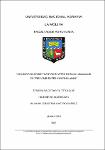Mostrar el registro sencillo del ítem
Aclimatación de plantas in vitro de Stevia rebaudiana B. en tres ambientes controlados
| dc.contributor.advisor | Tapia y Figueroa, María de Lourdes | |
| dc.contributor.author | Castro Suárez, Álvaro Sebastián | |
| dc.date.accessioned | 2023-05-25T01:49:56Z | |
| dc.date.available | 2023-05-25T01:49:56Z | |
| dc.date.issued | 2023 | |
| dc.identifier.uri | https://hdl.handle.net/20.500.12996/5815 | |
| dc.description | Universidad Nacional Agraria La Molina. Facultad de Agronomía. Departamento Académico de Fitotecnia | es_PE |
| dc.description.abstract | Stevia rebaudiana B. (Asteracea) es una especie originaria de Paraguay, apreciada por el poder edulcorante de sus hojas que es 300 veces mayor que el de la sacarosa, contiene diversos esteviósidos y rebaudiósidos que no son metabolizados por nuestro organismo, portanto, no eleva el nivel de glucosa en sangre. Recientemente ha aumentado el interés en su propagación, no obstante, su semilla tiene un bajo porcentaje germinativo y las plantas presentan un pobre porcentaje de supervivencia. También se propaga vegetativamente por esquejes, pero no es suficiente para implementar sistemas de propagación masiva, es por estemotivo que el método más adecuado es la propagación in vitro ya que se puede obtener un mayor número de plantas en poco tiempo. El objetivo de esta investigación fue establecer cuál es el mejor ambiente para la aclimatación de plantas in vitro de Stevia. Los ambientes utilizados fueron un invernadero ubicado en la ciudad de Lima, y dos cámaras edafoclimáticas ubicadas en el Instituto de Biotecnología de la UNALM, donde se simularon las condiciones ambientales de la ciudad de Naju, ubicada en la provincia de Jeolla del Sur,Korea del Sur y la ciudad de Sullana, Piura. Se utilizaron 300 plantas in vitro provenientes del IBT por cada experimento y se evaluó el crecimiento de éstas y el porcentaje de supervivencia a los 30 días. Analizando los resultados obtenidos, es recomendable aclimatarestas plantas en una cámara climática configurada con el clima de Naju, aunque las plantas presentaran un menor crecimiento se logrará que la mayoría sobreviva al proceso. Por otro lado, las plantas aclimatadas en el ambiente de Piura crecen un poco más a comparación delos otros tratamientos, pero la supervivencia de plantas es menor debido a la mayortemperatura que posee esta zona. | es_PE |
| dc.description.abstract | Stevia rebaudiana B. (Asteracea) is a species native to Paraguay, appreciated for the sweetening power of its leaves, which is 300 times greater than that of sucrose, contains various steviosides and rebaudiosides that are not metabolized by our body, therefore, they are not raises the blood glucose level. Interest in its propagation has recently increased, however, its seed has a low germination percentage and the plants have a poor survival percentage. It is also propagated vegetatively by cuttings, but it is not enough to implementmassive propagation systems, it is for this reason that the most appropriate method is in vitropropagation, since a greater number of plants can be obtained in a short time. The objective of this research was to establish the best environment for the acclimatization of Stevia plantsin vitro. The environments used were a greenhouse located in the city of Lima, and two edaphoclimatic chambers located at the UNALM Institute of Biotechnology, where the environmental conditions of the city of Naju, located in the province of South Jeolla, SouthKorea, were simulated. Sur and the city of Sullana, Piura. 300 in vitro plants from the IBT were used for each experiment and their growth and the percentage of survival at 30 days were evaluated. Analyzing the results obtained, it is advisable to acclimatize these plants ina climatic chamber configured with the climate of Naju, even if the plants show less growth,most of them will survive the process. On the other hand, plants acclimatized to the Piura environment grow a little more compared to the other treatments, but plant survival is lowerdue to the higher temperature in this area. | es_PE |
| dc.format | application/pdf | es_PE |
| dc.language.iso | spa | es_PE |
| dc.publisher | Universidad Nacional Agraria La Molina | es_PE |
| dc.rights | info:eu-repo/semantics/openAccess | es_PE |
| dc.rights.uri | https://creativecommons.org/licenses/by-nc-nd/4.0/ | es_PE |
| dc.subject | Aclimatación | es_PE |
| dc.subject | Stevia rebaudiana | es_PE |
| dc.subject | Cultivo in vitro | es_PE |
| dc.subject | Ensayos | es_PE |
| dc.subject | Perú | es_PE |
| dc.title | Aclimatación de plantas in vitro de Stevia rebaudiana B. en tres ambientes controlados | es_PE |
| dc.type | info:eu-repo/semantics/bachelorThesis | es_PE |
| thesis.degree.discipline | Agronomía | es_PE |
| thesis.degree.grantor | Universidad Nacional Agraria La Molina. Facultad de Agronomía | es_PE |
| thesis.degree.name | Ingeniero Agrónomo | es_PE |
| dc.subject.ocde | https://purl.org/pe-repo/ocde/ford#4.01.06 | es_PE |
| renati.author.dni | 70069998 | es_PE |
| dc.publisher.country | PE | es_PE |
| dc.type.version | info:eu-repo/semantics/publishedVersion | es_PE |
| renati.advisor.orcid | https://orcid.org/0000-0002-5000-3504 | es_PE |
| renati.advisor.dni | 10437704 | es_PE |
| renati.type | https://purl.org/pe-repo/renati/type#tesis | es_PE |
| renati.level | https://purl.org/pe-repo/renati/level#tituloProfesional | es_PE |
| renati.discipline | 811036 | es_PE |
| renati.juror | Casas Díaz, Andrés Virgilio | |
| renati.juror | Julca Otiniano, Alberto Marcial | |
| renati.juror | Eguiluz De La Barra, Ana Luzmeira |
Ficheros en el ítem
Este ítem aparece en la(s) siguiente(s) colección(ones)
-
AGR-FT Tesis [269]





